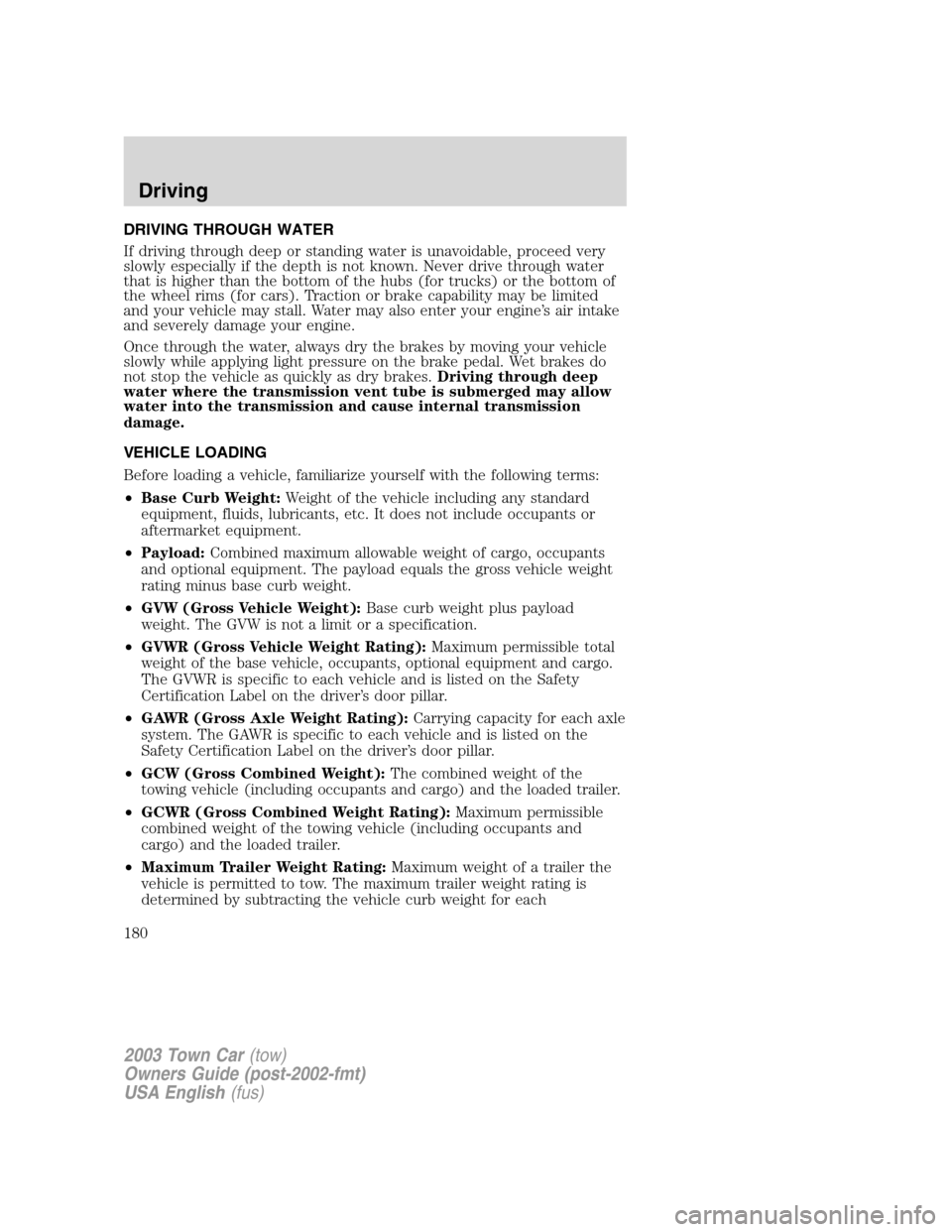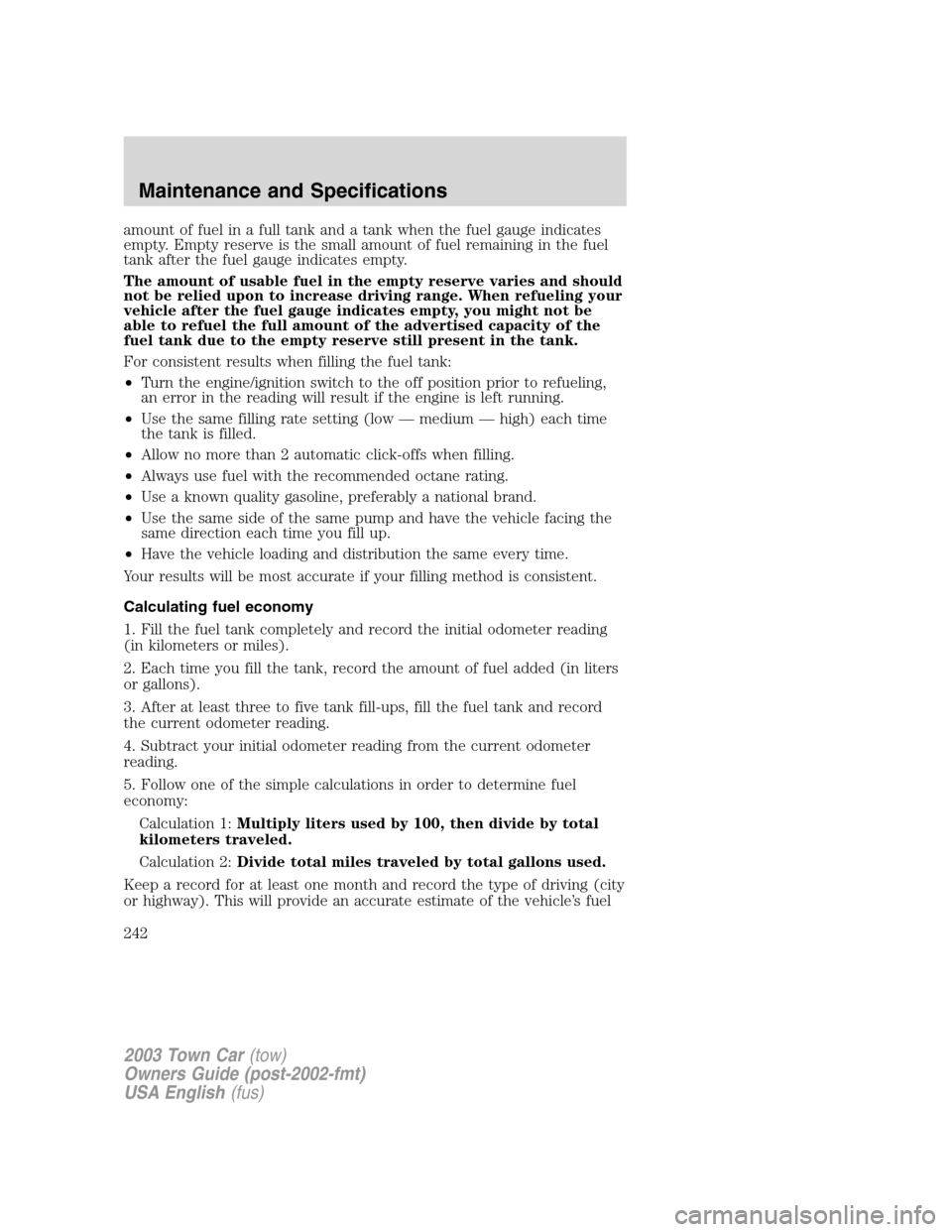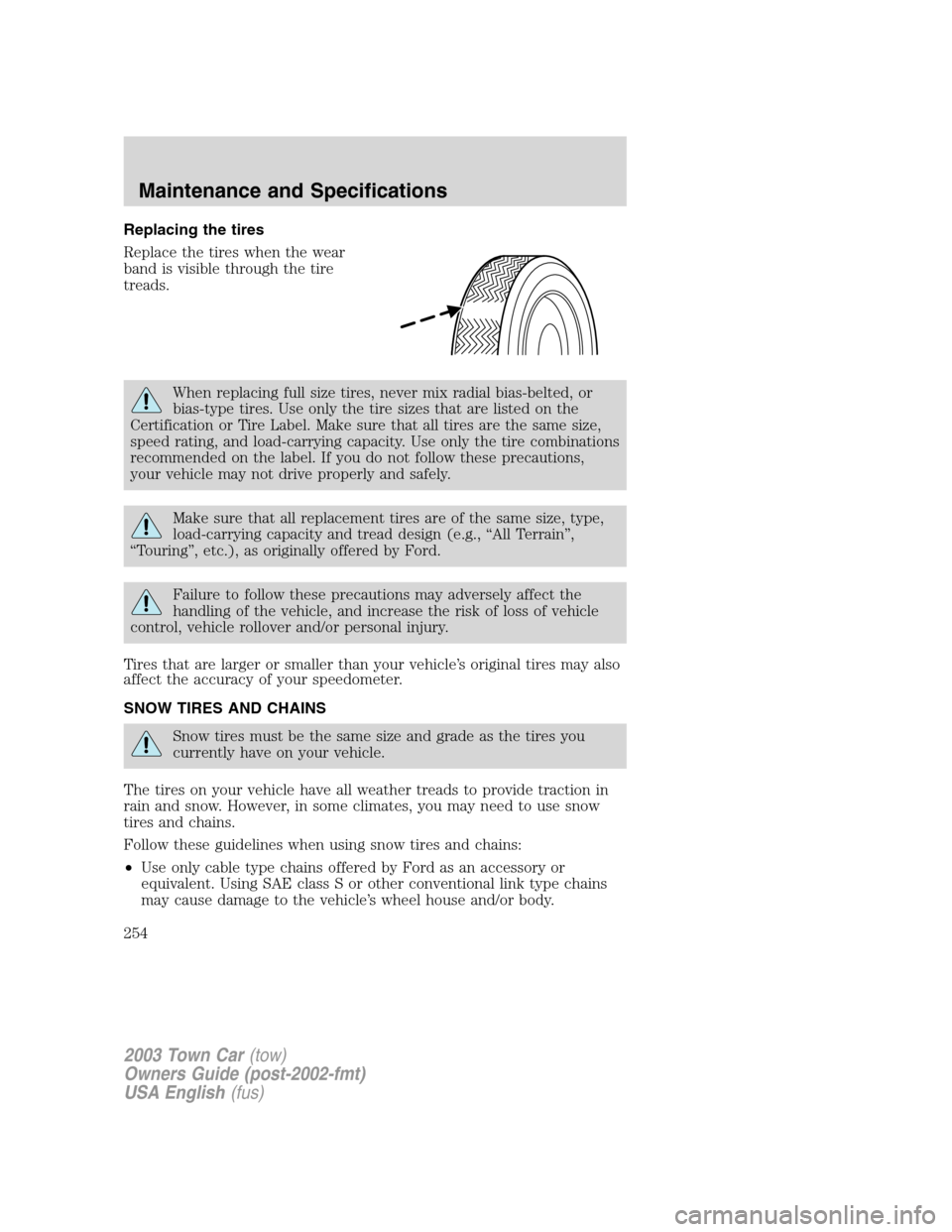2003 LINCOLN TOWN CAR load capacity
[x] Cancel search: load capacityPage 180 of 272

DRIVING THROUGH WATER
If driving through deep or standing water is unavoidable, proceed very
slowly especially if the depth is not known. Never drive through water
that is higher than the bottom of the hubs (for trucks) or the bottom of
the wheel rims (for cars). Traction or brake capability may be limited
and your vehicle may stall. Water may also enter your engine’s air intake
and severely damage your engine.
Once through the water, always dry the brakes by moving your vehicle
slowly while applying light pressure on the brake pedal. Wet brakes do
not stop the vehicle as quickly as dry brakes.Driving through deep
water where the transmission vent tube is submerged may allow
water into the transmission and cause internal transmission
damage.
VEHICLE LOADING
Before loading a vehicle, familiarize yourself with the following terms:
•Base Curb Weight:Weight of the vehicle including any standard
equipment, fluids, lubricants, etc. It does not include occupants or
aftermarket equipment.
•Payload:Combined maximum allowable weight of cargo, occupants
and optional equipment. The payload equals the gross vehicle weight
rating minus base curb weight.
•GVW (Gross Vehicle Weight):Base curb weight plus payload
weight. The GVW is not a limit or a specification.
•GVWR (Gross Vehicle Weight Rating):Maximum permissible total
weight of the base vehicle, occupants, optional equipment and cargo.
The GVWR is specific to each vehicle and is listed on the Safety
Certification Label on the driver’s door pillar.
•GAWR (Gross Axle Weight Rating):Carrying capacity for each axle
system. The GAWR is specific to each vehicle and is listed on the
Safety Certification Label on the driver’s door pillar.
•GCW (Gross Combined Weight):The combined weight of the
towing vehicle (including occupants and cargo) and the loaded trailer.
•GCWR (Gross Combined Weight Rating):Maximum permissible
combined weight of the towing vehicle (including occupants and
cargo) and the loaded trailer.
•Maximum Trailer Weight Rating:Maximum weight of a trailer the
vehicle is permitted to tow. The maximum trailer weight rating is
determined by subtracting the vehicle curb weight for each
2003 Town Car(tow)
Owners Guide (post-2002-fmt)
USA English(fus)
Driving
180
Page 242 of 272

amount of fuel in a full tank and a tank when the fuel gauge indicates
empty. Empty reserve is the small amount of fuel remaining in the fuel
tank after the fuel gauge indicates empty.
The amount of usable fuel in the empty reserve varies and should
not be relied upon to increase driving range. When refueling your
vehicle after the fuel gauge indicates empty, you might not be
able to refuel the full amount of the advertised capacity of the
fuel tank due to the empty reserve still present in the tank.
For consistent results when filling the fuel tank:
•Turn the engine/ignition switch to the off position prior to refueling,
an error in the reading will result if the engine is left running.
•Use the same filling rate setting (low—medium—high) each time
the tank is filled.
•Allow no more than 2 automatic click-offs when filling.
•Always use fuel with the recommended octane rating.
•Use a known quality gasoline, preferably a national brand.
•Use the same side of the same pump and have the vehicle facing the
same direction each time you fill up.
•Have the vehicle loading and distribution the same every time.
Your results will be most accurate if your filling method is consistent.
Calculating fuel economy
1. Fill the fuel tank completely and record the initial odometer reading
(in kilometers or miles).
2. Each time you fill the tank, record the amount of fuel added (in liters
or gallons).
3. After at least three to five tank fill-ups, fill the fuel tank and record
the current odometer reading.
4. Subtract your initial odometer reading from the current odometer
reading.
5. Follow one of the simple calculations in order to determine fuel
economy:
Calculation 1:Multiply liters used by 100, then divide by total
kilometers traveled.
Calculation 2:Divide total miles traveled by total gallons used.
Keep a record for at least one month and record the type of driving (city
or highway). This will provide an accurate estimate of the vehicle’s fuel
2003 Town Car(tow)
Owners Guide (post-2002-fmt)
USA English(fus)
Maintenance and Specifications
242
Page 254 of 272

Replacing the tires
Replace the tires when the wear
band is visible through the tire
treads.
When replacing full size tires, never mix radial bias-belted, or
bias-type tires. Use only the tire sizes that are listed on the
Certification or Tire Label. Make sure that all tires are the same size,
speed rating, and load-carrying capacity. Use only the tire combinations
recommended on the label. If you do not follow these precautions,
your vehicle may not drive properly and safely.
Make sure that all replacement tires are of the same size, type,
load-carrying capacity and tread design (e.g.,“All Terrain”,
“Touring”, etc.), as originally offered by Ford.
Failure to follow these precautions may adversely affect the
handling of the vehicle, and increase the risk of loss of vehicle
control, vehicle rollover and/or personal injury.
Tires that are larger or smaller than your vehicle’s original tires may also
affect the accuracy of your speedometer.
SNOW TIRES AND CHAINS
Snow tires must be the same size and grade as the tires you
currently have on your vehicle.
The tires on your vehicle have all weather treads to provide traction in
rain and snow. However, in some climates, you may need to use snow
tires and chains.
Follow these guidelines when using snow tires and chains:
•Use only cable type chains offered by Ford as an accessory or
equivalent. Using SAE class S or other conventional link type chains
may cause damage to the vehicle’s wheel house and/or body.
2003 Town Car(tow)
Owners Guide (post-2002-fmt)
USA English(fus)
Maintenance and Specifications
254
Page 268 of 272

recommendations ...................228
refill capacities ........................256
specifications ..................257, 259
Exhaust fumes ..........................169
F
Fail safe cooling ........................235
Floor mats .................................112
Fluid capacities .........................256
Foglamps .....................................75
Fuel ............................................237
calculating fuel
economy ....................89, 106, 241
cap ...........................................239
capacity ...................................256
choosing the right fuel ...........240
comparisons with EPA fuel
economy estimates .................244
detergent in fuel .....................241
filling your vehicle
with fuel ..................237, 239, 241
filter, specifications ........241, 255
fuel filler door override ..........110
fuel filler door release ............110
fuel pump shut-off switch .....186
improving fuel economy ........241
octane rating ...................240, 259
quality ......................................240
running out of fuel .................241
safety information relating
to automotive fuels ................237
Fuses ..................................187–188
G
Gas cap (see Fuel cap) ............239
Gas mileage
(see Fuel economy) .................241
Gauges .........................................15GAWR (Gross Axle
Weight Rating) ..........................180
definition .................................180
driving with a heavy load ......180
location ....................................180
GVWR (Gross Vehicle
Weight Rating) ..........................180
calculating ...............................180
definition .................................180
driving with a heavy load ......180
location ....................................180
H
Hazard flashers .........................186
Head restraints .........................128
Headlamps ...................................74
aiming ........................................76
autolamp system .......................74
bulb specifications ....................79
daytime running lights .............75
flash to pass ..............................76
high beam .................................75
replacing bulbs .........................80
turning on and off ....................74
HomeLink universal
transceiver (see
Garage door opener) ..................90
Hood ..........................................223
I
Ignition ...............................166, 259
Infant seats
(see Safety seats) .....................158
Inspection/maintenance
(I/M) testing ..............................246
Instrument panel
cleaning ...................................218
cluster ........................................10
lighting up panel and interior .76
2003 Town Car(tow)
Owners Guide (post-2002-fmt)
USA English(fus)
Index
268